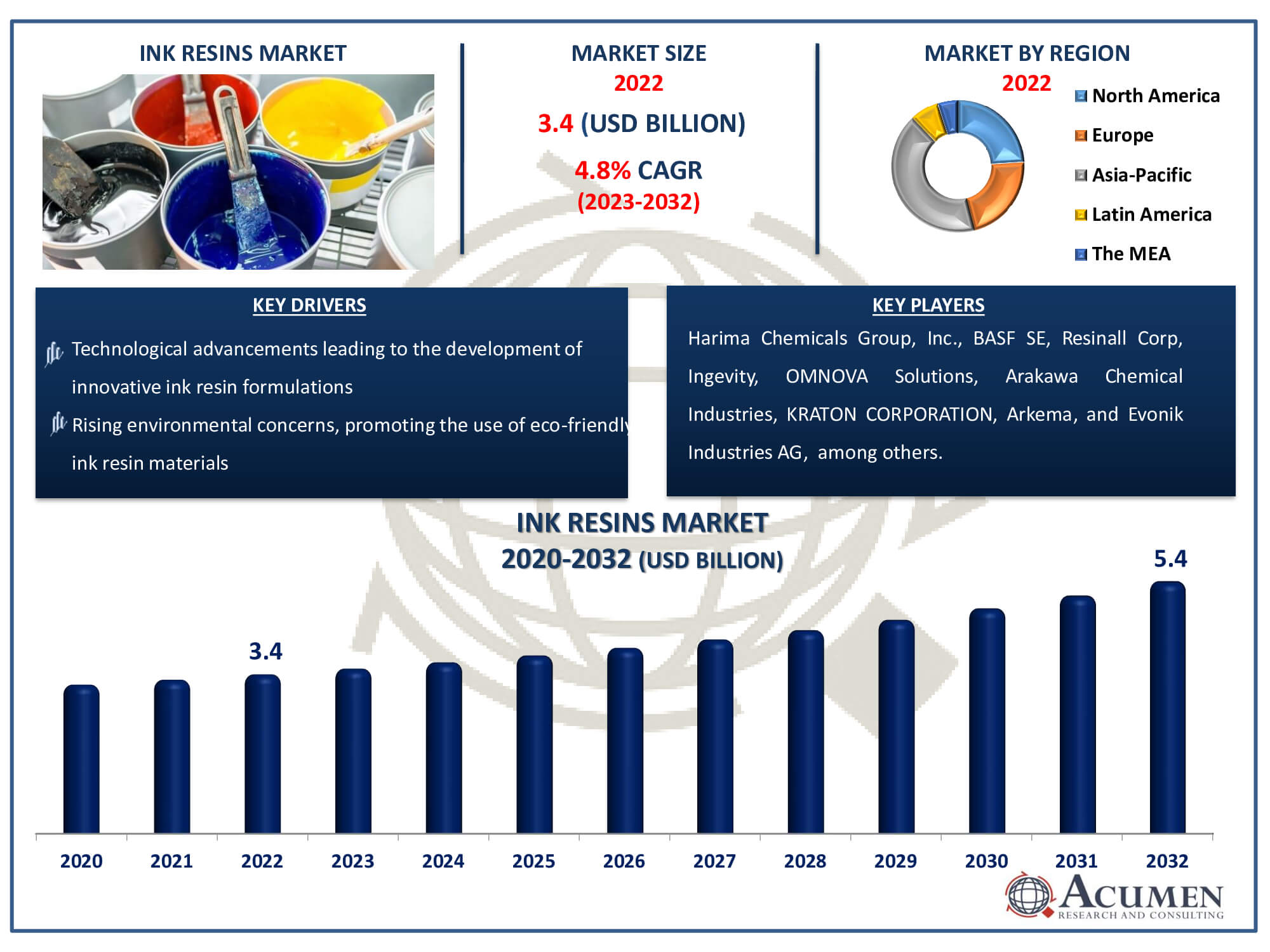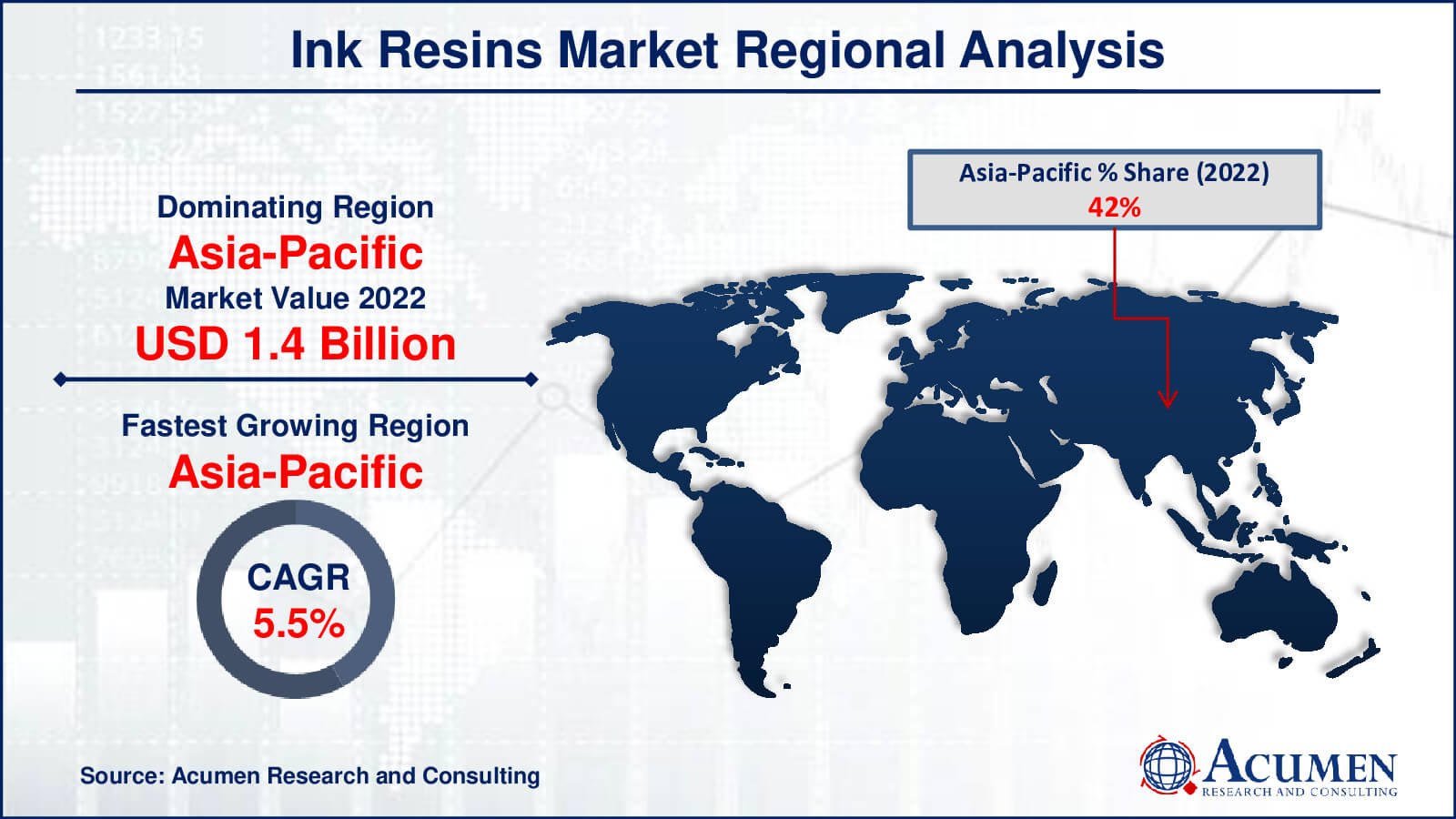March 2025
Ink Resins Market Size accounted for USD 3.4 Billion in 2022 and is estimated to achieve a market size of USD 5.4 Billion by 2032 growing at a CAGR of 4.8% from 2023 to 2032.
The Ink Resins Market Size accounted for USD 3.4 Billion in 2022 and is estimated to achieve a market size of USD 5.4 Billion by 2032 growing at a CAGR of 4.8% from 2023 to 2032.
Ink Resins Market Highlights

Ink resins, essential in producing printing inks, dictate the ink’s properties and functionality, influencing gloss, adhesion, durability, drying time, color stability, and resistance to chemicals and abrasion. Acting as binding agents, these compounds maintain pigment particle cohesion and ensure adhesion to printing surfaces while providing necessary texture, flow, and drying attributes. Whether synthesized chemically or sourced naturally, ink resin selection hinges on the ink’s specific needs and the printing method be it flexographic, gravure, offset, or digital printing. These resins, integral in ink manufacture, modify the final product’s properties in pigment and tinting dispersions, showcasing stability, surface appearance, gloss, flow, solvency, and dilatability across various printing techniques like flexographic, inkjet, offset, and sheetfed printing.
Global Ink Resins Market Dynamics
Market Drivers
Market Restraints
Market Opportunities
Ink Resins Market Report Coverage
| Market | Ink Resins Market |
| Ink Resins Market Size 2022 | USD 3.4 Billion |
| Ink Resins Market Forecast 2032 | USD 5.4 Billion |
| Ink Resins Market CAGR During 2023 - 2032 | 4.8% |
| Ink Resins Market Analysis Period | 2020 - 2032 |
| Ink Resins Market Base Year |
2022 |
| Ink Resins Market Forecast Data | 2023 - 2032 |
| Segments Covered | By Type, By Printing Process, By Printing Ink, By Application, And By Geography |
| Regional Scope | North America, Europe, Asia Pacific, Latin America, and Middle East & Africa |
| Key Companies Profiled | Harima Chemicals Group, Inc., BASF SE, Resinall Corp, Ingevity, OMNOVA Solutions Inc., Arakawa Chemical Industries Ltd., KRATON CORPORATION, Arkema, Evonik Industries AG, Gellner Industrial LLC, Shenghong Chemical, and Meilida Pigment Industry Co., Ltd. |
| Report Coverage |
Market Trends, Drivers, Restraints, Competitive Analysis, Player Profiling, Covid-19 Analysis, Regulation Analysis |
Ink Resins Market Insights
With the increasing utilization of flexible packaging and folding cartons, the global industry is anticipated to grow in the ink resins market forecast period. Furthermore, an improvement in the supply of raw materials for ink resin production is expected to bolster market growth. Ongoing strategic partnerships between ink producers and resin manufacturers, aimed at ensuring continuous returns, are projected to assist in the growth of the ink resin market over the forecast period. These partnerships benefit both ink producers, securing feedstock supplies, and resin providers.
A major driver for ink resin market growth in the next seven years is the increased demand for packaged foods and beverages. However, the switch from traditional to internet and screen marketing is anticipated to act as a key restricting factor in the ink resin market's growth. Additionally, the increase in feedstock petrochemical ink resin prices is expected to hinder market growth.
In the coming years, the development of environmentally friendly ink resins is expected to open up new market avenues. Moreover, the increased preference for water-based inks, driven by strict environmental protection policies, is anticipated to contribute to market growth over the ink resins industry forecast period. However, the anticipated rise in prices and volatility of raw materials are expected to hinder the growth of the ink resins market. Furthermore, the raw material industry for ink resins is nearing consolidation, bolstering suppliers' negotiation strength but adversely impacting market growth. The ink industry's end-use sectors are expanding globally in tandem with economic growth, and thus, geopolitical challenges in specific regions are influencing the global market for ink resins.
Packaging stands as a crucial requirement for every product, safeguarding it against various factors like mishandling and harsh environments. Appealing packaging also significantly influences consumer purchasing decisions, underscoring the importance of good packaging. Manufacturers and consumers alike have recognized these packaging benefits, resulting in substantial growth in the global packaging industry in recent years. All types of packaging require printing, and ink resins are among the essential raw materials needed for printing inks. Consequently, the projected growth in the packaging sector is poised to drive the global ink resin market.
Digitalization refers to the process of developing photos and texts digitally a phenomenon initiated by the advancements in computers, mobile devices, and the Internet. Currently, numerous textbooks, novels, and illustrative books are available online, and marketing campaigns increasingly rely on digital formats, reducing the need for printed materials. The burgeoning trend in e-commerce worldwide is impacting industries like printing and publication, thereby restraining the global ink resin market during the forecast period.
Within the market, various types of ink resins exist, including modified rosins, polyamides, acrylics, hydrocarbon resins, and polyurethanes. Each type has its own set of advantages and disadvantages, allowing ink resins to be tailored precisely to specific printing ink requirements. This customization extends to particular applications like packaging, publishing, and commercial printing. However, the development of such high-precision ink resins relies heavily on close collaboration between manufacturers of printing inks and ink additives. This cooperative approach not only enhances profitability for ink resin manufacturers but also ensures the creation of tailored solutions for diverse printing needs.
Ink Resins Market Segmentation
The worldwide market for ink resins is split based on type, printing process, printing ink, application, and geography.
Ink Resin Types
According to ink resins industry analysis, the most significant category in the market is the modified rosin subsegment. Modified rosin is well known for its strength and excellent adhesive qualities, making it compatible with a wide range of printing applications. These characteristics, which promote adhesion, durability, and superior pigment dispersion, are responsible for its domination. The fact that this subsegment is so common indicates that manufacturers who are looking for consistency and versatility in ink formulas are drawn to it, which has led to a major increase in the market's growth and recognition.
Ink Resins Printing Processes
Lithography is the largest subsegment of the printing process market, because it is so versatile and widely employed. Lithography is a well-known large-volume printing method that is precise and economical in a variety of industries. Its superior print quality, versatility on many substrates, and effective mass production capabilities account for its dominance. Because of its versatility in meeting a range of printing requirements, lithography continues to hold a sizable market share. This makes it attractive to sectors looking for dependable, high-resolution printing solutions, further solidifying its position as the industry's top printing method.
Ink Resin Printing Inks
With the biggest market share, the UV-cured ink subsegment dominates the printing ink category's ink resins market. The remarkable qualities of UV-cured ink, such as its quick curing under UV light, increased durability, vivid colour reproduction, and decreased environmental effect, are responsible for its supremacy. Because of its adaptability to a wide range of substrates and capacity to produce crisp, durable prints, UV-cured inks are the market leader and are a preferred option for packaging, labels, and specialty printing. This choice reflects the industry's trend towards environmentally friendly, high-performance ink solutions.
Ink Resin Applications
In terms of Ink resins market analysis, with the biggest share in the industry, the printing and publication subsegment declares its supremacy. The importance of ink resins in satisfying the strict requirements of fine printing processes, such as those used to produce books, periodicals, and newspapers, is the primary cause of its popularity. Their capacity to guarantee rich colours, superior adherence, and quick drying times is ideal for meeting the complex demands of publishing. Designed specifically for this market, ink resins provide consistency and accuracy, making them the go-to option and strengthening printing and publication's stronghold.
Ink Resins Market Regional Outlook
North America
Europe
Asia-Pacific
Latin America
The Middle East & Africa

Ink Resins Market Regional Analysis
Asia Pacific held the leading market share of the ink resins market in 2022 as a result of the growing demand for printing inks in the packaging sector. China, owing to its dominant packaging industry, was chiefly responsible for driving ink resin demand in the region. Considering the upward trend in online shopping and packaged foods, Asia Pacific is anticipated to maintain market dominance in terms of volume. North America's burgeoning food & beverage industry is projected to experience steady growth rates. Moreover, the rapid industrialization in emerging economies such as India, Brazil, and Mexico signals a high potential for ink resin demand in these regions.
Ink Resins Market Players
Some of the top ink resins companies offered in our report includes Harima Chemicals Group, Inc., BASF SE, Resinall Corp, Ingevity, OMNOVA Solutions Inc., Arakawa Chemical Industries Ltd., KRATON CORPORATION, Arkema, Evonik Industries AG, Gellner Industrial LLC, Shenghong Chemical, and Meilida Pigment Industry Co., Ltd.
Looking for discounts, bulk pricing, or custom solutions? Contact us today at sales@acumenresearchandconsulting.com
March 2025
March 2023
July 2024
June 2020